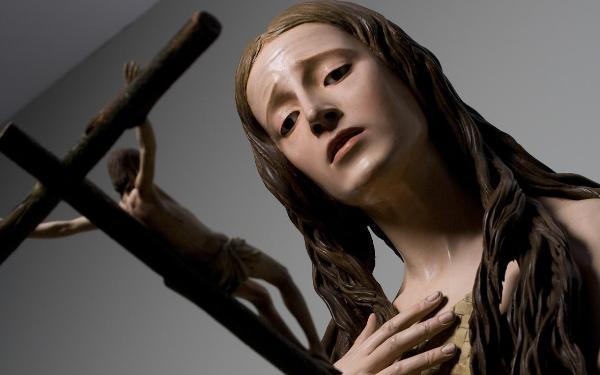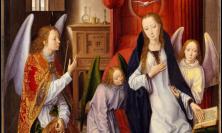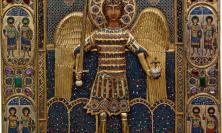An extraordinary exhibition of Spanish religious art from the seventeenth century is now in its final week at The National Gallery. James Hanvey SJ discusses key pieces from The Sacred Made Real collection and urges visitors to take this unique opportunity to let the paintings and sculptures speak to their faith, and transform their understanding of the world around them.
The Sacred Made Real, a remarkable exhibition currently in its final week at The National Gallery in London, has assembled religious paintings and sculptures from the golden age of Spanish expansion in the 17th century. It places the two art forms together to allow the visitor to see the inspirational and technical interplay between paintings and sculpture to produce a ‘living’ art. This exhibition reveals a Spain – with its vibrant, daring aesthetic, its faith and confidence – that few outside the country who are not art specialists would have access to, and few inside Spain would appreciate in all the dimensions that the exhibition captures.
Many positive reviews of the collection have tended to stress the cultural significance of an exhibition so unembarrassed in its Catholicity being displayed in a once anti-Spanish, Protestant England. That might be an interesting point if England were still in some sense a Protestant country, but a long tradition of religiously indifferent government, and the slow, quiet marginalisation of the Church of England, has made the historical reference otiose. The exhibition does much more than challenge the religious sensibilities of a dwindling faith; it reaches across the centuries to confront, invite and enrich the contemporary secular imagination. To do this effectively it needs an accessible frame of reference that can help a curious and possibly scandalised viewer understand what is happening, and the staging of the exhibition provides this.
The exhibition, organised and presented by Dr Xavier Bray, achieves this in a way that is both admirable and subtle. The sensitive lighting and spacing of the pieces, many of which are on loan from Spanish churches and cathedrals, creates an atmosphere in which the ‘viewer’ is allowed to take time to establish a relationship that is personal and even contemplative. This is critical to the appreciation of the way in which both the paintings and the polychrome sculptures work. The combined artistic technique of the great painters and sculptors of this time produce dynamic, fluid figures which are ‘alive’; their faith and the imagination that it inspires invite the establishment of a relationship that might be described by the Spanish word ‘devocion’. Even where there is no religious connection, there will be a deeply human one. The works of Pedro de Mena, especially his Mater Dolorosa (‘The Virgin of Sorrows’), and his Mary Magdalen meditating on the crucifix (an image of which accompanies this review) are particular examples of this. The face of the Mater Dolorosa has such an exquisite expression of pain and loss while the hands, closed in supplication and acceptance, somehow intensify yet contain the agony. Tears, made from glue or resin, stream down her face. There is an immediate recognition of the reality of human suffering. This work not only captures a physical reality; it triggers a memory in us all.
Anyone who has ever watched someone they love suffer can relate to the Mater Dolorosa. It is not only that the sacred has been made real, but that the reality of our own lives has been made present. It is not only the story of Mary and Christ that is told here, it is our story too. We are in the presence of an experience at once intensely personal and private, yet universal.
Likewise with the Magdalen. The accomplished skill and delicacy of Mena presents to us a repentant Mary Magdalen contemplating the crucifix. She leans forward, in movement, both rapt in the cross and yet also following it. The achievement of the artist is to immediately establish this relationship between the ‘living’ Magdalen,and the object of the cross with the Crucified that captivates and leads her. In an imperceptible way, the relationship between Mary and the cross that she holds, itself already a symbolic representation of a real event, models our relationship with the very statute that we gaze upon. This is part of the secret of all these works. They are not there just to be viewed or admired, but to draw us into a relationship with them and, through them, to the reality they represent. In this wonderfully mobile sculpture, the Magdalen, her face alive with repentance but filled with concentration, directs us to the intense energy that takes her on the new journey that Christ is opening up: the apostle to the apostles, become an apostle to us. Here, she meets us on our way and allows us to question her. In the words of the ancient Easter hymn, Victimae Paschali Laudes, ‘Tell us Mary, what did you see upon the way?’ For Pedro de Mena’s Magdalen, it is certainly an interior vision of mystical intensity that draws her, but it is also something real in the world and in history: the person of Christ. Mena is not only reminding us of the great mystical tradition that flowered in Spain at this time, he is also inviting us to reflect and to follow. His Magdalen is focused on Christ who offers a costly salvation, and yet that perfectly poised delicate position of her hand above her breast also tells us of her gratitude: ‘all this ‘para mí?’ (‘for me?’). It is a movement and reflection which St Ignatius asks us frequently to consider in the text of his Spiritual Exercises, another work which shaped the religious imagination of the 17th and 18th century.
The Mater Dolorosa is in a room dedicated to the dead Christ. She gazes upon the Dead Christ, the body of her son sculpted with a shocking and moving realism by Gregorio Fernández. Here, wherever we stand and from whichever angle we look we are in no doubt that we are in the presence of a real, brutal and ugly death. There is nothing sentimental about its portrayal. Fernández has gone to exceptional lengths to achieve this realism: the corpse is plastic and lifeless; the bluish-tint of the cold flesh, the bruised and contorted face, the unseeing half-open eyes, the effect of clotted blood have all been faithfully and expertly reproduced. The effect could be overwhelming if we did not have the Mater Dolorosa and the moving picture of the Lamentation over the Dead Christ by Jusepe de Ribera to guide us. The picture shows us a community of faith, Mary, John and Mary Magdalen, gathered around the dead Christ, all engaged in moving personal acts of loving reverence.
This is not some exercise in ghoulish horror; it calls upon the ability that faith possesses to look steadily upon the real without attempting to disguise it. The eyes of faith do not turn away from reality but meet it with a calm fortitude; they see with a love that can penetrate to the very depth of human ugliness and not turn away. The Spanish painters of this period called their technique of painting the sculptures with accurate colour and flesh-tones, encarnación (‘incarnation’). The exhibition is a glorious demonstration of the theological and artistic appropriateness of this description.
It would be a mistake to think that The Sacred Made Real is devoted to the portrayal of human and divine suffering. It is also about the celebration of the Christian faith, its joy and the vision of its hope. In many of the sculptures and paintings there is an attention to the Our Lady in her glory, and to the joy and peace of the saints. There are the beautiful faces of the Carthusian monks sheltering under the cloak of The Virgin of Mercy of Las Cuevas: they have a living radiance, filled with naturalness and life that is both natural and supernatural.
The collection also focuses its attention on the interior landscape of the mystic. We see this most clearly in two paintings which show visions of St Bernard: The Miracle of the Lactation by Alonso Cano and Christ embracing St Bernard of Clairvaux, by Francisco Ribalta. Both represent completely interior moments as if they take place in the external, ‘real’ world. The image of Bernard being embraced by Christ has a particular power and attraction. The figures of Christ and Bernard have a sculptural solidity and weight, yet the emotion betrays a wonderful ‘lightness’, almost as if body and soul have found a new integration. This is captured in the sweetness of Bernard’s ecstatic smile as he is caught in the arms of a Christ who is descending from the cross to embrace him. The loving, tender, expression that radiates from Christ communicates the immediacy of a moment and the intensity of a relationship that represents not only a moral and spiritual transformation but a material one as well. Gravity and matter, time and space, interiority and solid forms of the exterior world are all rearranged yet remain themselves, in this world. Such art displays a ‘sacramental’ quality in that it not only mediates the sacred made tangible, but the interior world with all it strangeness, intensity and intimacy is made accessible and public without losing its personal and private character.
This points us to another dimension of the artistic vision that informs the exhibition with such delicacy. There is no doubt that these artists were influenced by the Italian school of chiaroscuro, represented in the dramatic realism of painters like Caravaggio. Yet, what the Spanish artists achieve is something even more intriguing. When considering the paintings – which also have a dramatic and sculptural quality, especially evident in Zurbarán’s Christ on the Cross – one becomes aware that the drama of ‘light and dark’ is not only used to create a sense of density and solidity in form and matter, it has been moved inward. It is made to reflect the great drama of the soul in its life with God. There can be few clearer examples of this than Zurbarán’s great masterpiece which is part of the National’s own collection, St Francis in Meditation. This is a Francis profoundly lost in the divine mystery, a Francis who is both alive to the darkness of the God and yet dead to the pale light of the world. Standing before the painting we are drawn into the mystery itself, and so the saint mediates the divine darkness which both penetrates and absorbs him. The picture stands in a room dedicated to St Francis of Assisi, which also features the exquisite yet slightly eerie statue inspired by Zurbarán’s picture of the saint, St Francis Standing in Ecstasy, again by Pedro de Mena. This small statue, of a man suspended in a rapture which not even death can break, is rarely on display and it is a considerable achievement of this exhibition to have presented it so expertly in its dramatic immediacy.
In this period of Spanish art and culture there is a concentration on all the great reforming saints – Bruno, Francis, Bernard, John of God, Ignatius of Loyola. They reflect the religious and political élan of the age: Spain is not only set on acquiring a material empire, but its confident Catholicism seeks spiritual conquest also. Hence, the exhibition offers a subdued but powerful paradox: the sacred and the secular. On the one hand there is the cultural and secular confidence to produce these works of high art with their technical accomplishment, yet the works themselves show a counter reality. They show a faith that is won through discipline, self-denial and sacrifice. They make real a passion for the kingdom before which the glories of empire must fade into a passing dream of vanity and history.
The exhibition, through the art that it makes available to us, offers us new experiences of our world infused with sacredness. It shows us how the human, through the lives of holy witnesses and the art that takes them as its subject, can open our eyes to a reality in our midst. It can transform our understanding and our living.
To accompany the exhibition, the National has produced an elegant catalogue with informative articles and a fine audio guide. The music, composed by Stephen Hough and based on a Mass by Tomás Luis de Victoria, is especially beautiful and moving.
With The Sacred Made Real, the National has given us a unique exhibition. It has imagination and a rare sensibility, both in communicating a period of religious and artistic brilliance to a contemporary secular culture and in having the courage to do so. The exhibition finishes on 24th January. It is unlikely that such a collection of exquisite pieces will be assembled again, so it is worth making the effort to get to see it before it closes. If you do you will never visit Spain and look at its churches and its art with the same eyes again. Maybe you will not look at the ‘real’ in the same way again either.
Rev. Dr. James Hanvey SJ lectures in Systematic Theology at Heythrop College, University of London.
The Sacred Made Real runs until 24 January 2010 in the Sainsbury Wing of The National Gallery, London WC2N 5DN.






